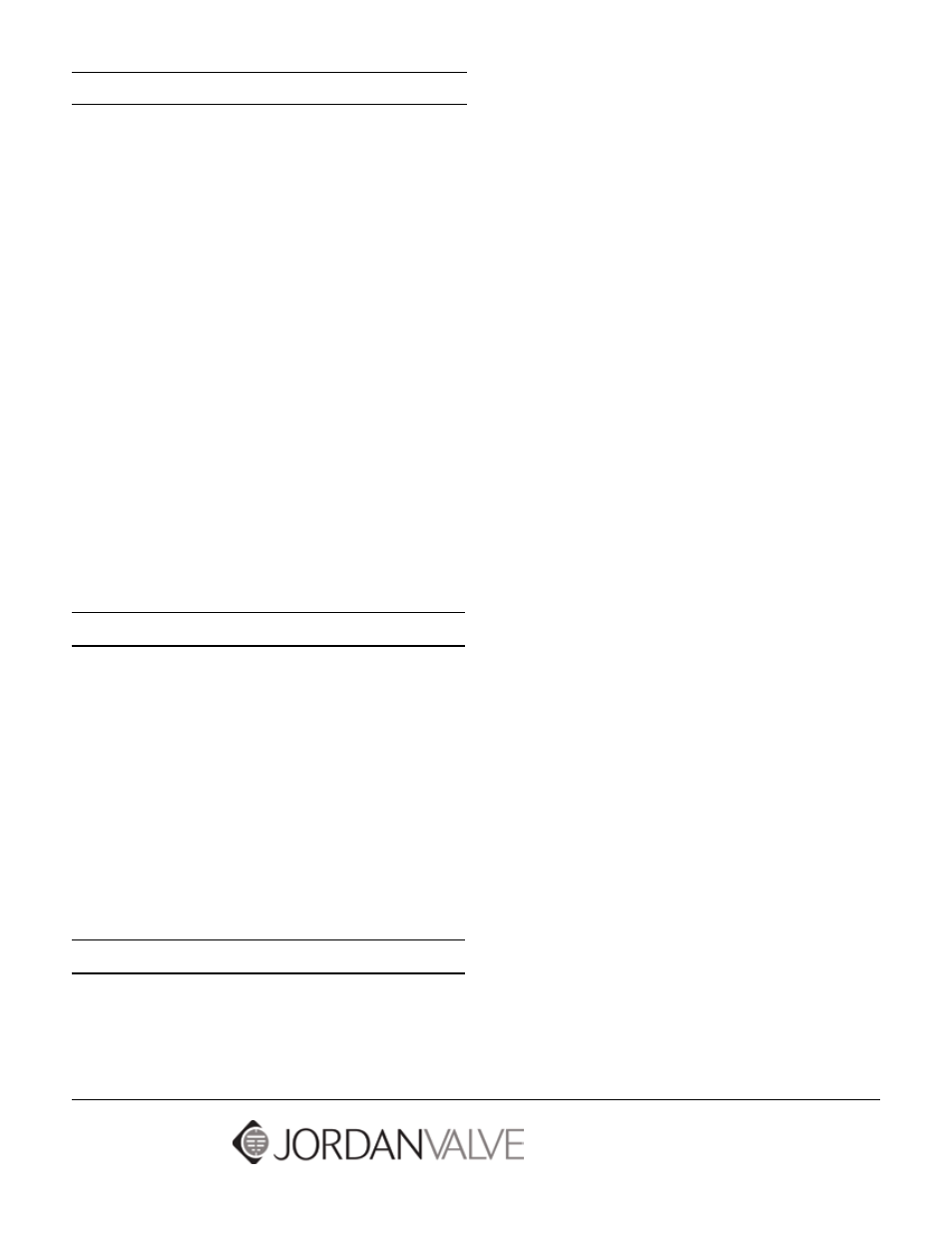Control line piping recommendation, Start-up, Trouble shooting – Jordan Valve Mark 608DS – Double Seated High Capacity Tank Blanketing Regulator User Manual
Page 2

A. Under Pressure: Controlled pressure too low; not
enough flow or no flow through valve.
B. Over Pressure: Valve will not close or controlled
pressure increases after valve closes.
C. Pressure Fluctuates: Controlled pressure rises and
falls, will not settle out under low loads.
The next step is to determine what could cause the
trouble. The third step is to locate and remedy the cause
by the process of elimination. Make no assumptions and
check the easy ones first. The guide below lists the con-
trolled pressure action, common causes and procedure
for checking each cause.
Controlled pressure action UNDER PRESSURE:
Valve undersized for application. Check capacity
required and valve capacity.
Line strainer screen clogged. Blow down strainers
or visually check that they are clear.
Incorrect setting on range spring. Vary the setting
and check response.
Main valve diaphragm or balance diaphragm rup-
tured. See action on valve maintenance.
Malfunction of other piping components. Check
for leaking safety valves, inadvertently opened or
closed valves.
Controlled pressure action OVER PRESSURE:
Incorrect setting on range spring. Vary the setting
and check response.
Main valve seats leaking. Close inlet shut-off valve,
allow downstream pressure to bleed off, close out-
let valve and remove loading pressure tubing. Back
out adjusting screw on valve until free. Crack open
inlet shut-off valve - if the fluid issues from the main
valve port, the main valve seats are leaking.
By-pass shut-off leaking. During period of leakage
close outlet shut-off valve, observe downstream
pressure gauge.
Controlled Pressure Fluctuates:
Valve oversized. Check capacity required and valve
capacity.
Note: Valve is NOT field repairable. Contact your local
representative or 800-543-7311 for repair information.
Control Line Piping Recommendation
Keep the regulator as close to the tank as possible
and as high as possible.
Minimize the length of the downstream pipe com-
ing from the valve.
NEVER reduce the pipe size on the valve outlet to
the tank. This line must always be as large as the
valve size, or one pipe size larger to assure it does
not act as a restriction.
Any downstream isolation valve after the regulator
must be a full port type. The isolation valve cannot
act as a restriction.
The sensing line must be a minimum of 3/4" pipe.
A sensing line isolation valve is recommended.
Again, must be full ported.
Slope the sensing line to the sensing port on the
tank.
Keep the sensing line as short and straight as pos-
sible.
For each 10 feet of sensing line, increase the line
size by one pipe diameter. (Especially important on
the blanket pressures of less than 5 inches of water
column).
Keep the sensing port on the tank as far removed
as possible from the downstream pipe outlet going
into the tank.
Start-Up
With the inlet, outlet, and bypass shutoff valves closed,
and no pressure in the downstream line:
1.
Slowly open the inlet valve just enough to start
flow through the valve. Observe the tank pressure
gauge. Increase the downstream pressure slowly
by gradually opening the inlet valve.
2.
Do not fully open the inlet valve until you are sure
that the regulator has control of the system. Usu-
ally, the handwheel on the inlet valve will turn freely
when this is achieved.
3.
To change the controlled pressure, adjust the
controlled pressure supplied to the top of the dia-
phragm.
Trouble Shooting
The first step in troubleshooting a piloted pressure regu-
lator is to classify the action of the controlled pressure
into one of the following categories:
3170 Wasson Road • Cincinnati, OH 45209 USA
Phone 513-533-5600 • Fax 513-871-0105
[email protected] • www.jordanvalve.com
Bulletin IM-MK608DS-1211
